Rare Half Dollars: Coins of Your Dreams
Posted onHalf dollars, America’s 50-cent coins, were introduced in 1794. Since then, they have seamlessly integrated into the nation’s currency, today holding a cherished place in collectors’ hearts. From the classic elegance of the Walking Liberty to the symbolic Franklin and Kennedy designs, each coin serves as a poignant representation of distinct eras. This article will discuss rare half dollar coins worth money, delving into:
- The reasons for their rarity.
- The most valuable half dollars.
- Where to find these sought-after pieces.
For a comprehensive list of the most valuable rare half dollar coins, watch this insightful video:
Why are half dollar coins rare?
Over time, half dollars have evolved into captivating treasures for coin collectors, valued not just for their visual appeal but also for their rarity. Gaining an understanding of the factors that contribute to this rarity is essential for deepening one’s appreciation of these coins.
- Mintages and Production Changes: The rarity of certain half dollars can be traced back to limited mintages and significant production changes over the years. For instance, early issues like the 1794 Flowing Hair Half Dollar had minimal mintage due to the challenges of coin production during that era. Similarly, shifts in coin designs, such as the transition from the Franklin Half Dollar to the Kennedy Half Dollar in 1964, marked distinct periods of production change, influencing the scarcity of specific issues.
- Historical Events and Melted Silver: Several historical events have played a pivotal role in the scarcity of half dollars. During times of economic uncertainty or wars, coins were often melted down for their silver content. The Silver Act of 1963, which led to the elimination of silver from most circulating coins, further impacted the availability of silver half dollars. As a result, coins from these periods are now scarce, with many lost to melting or removal from circulation.
- Hoarding: Intriguingly, half dollars have faced a unique fate at the hands of coin collectors. As certain issues gained recognition for their rarity, a phenomenon of hoarding emerged. Savvy collectors, aware of the potential future value, began accumulating specific half dollars, leading to reduced availability in the market. This deliberate act of preservation has contributed significantly to the scarcity of these coins, creating a fascinating aspect of numismatic history.
- Condition and Survival Rates: The preservation and survival rates of half dollars also play a crucial role in their rarity. Factors such as exposure to harsh environmental conditions, circulation wear, and mishandling impact the overall availability of well-preserved coins. As collectors increasingly prioritize coins in excellent condition, finding rare half dollars in pristine state becomes a greater challenge, elevating the rarity of high-grade specimens.
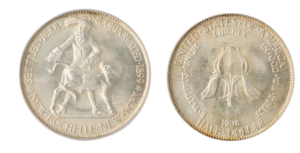
1938 New Rochelle Silver Commemorative Half PCGS MS66
How rare is a half dollar coin?
The rarity of half dollar coins is highly contingent on factors such as type, historical context, and public reception. Initially introduced in 1794, these coins have been in circulation since the early days of the U.S. Mint and can be categorized by their different designs. These include the early half dollars, namely Flowing Hair, Draped Bust, and Capped Bust, followed by the Seated Liberty, Barber, Walking Liberty, and, lastly, Franklin and Kennedy half dollars. Today, commemorative half dollars contribute to this diverse landscape, featuring unique designs commemorating significant events.
As coin connoisseurs will know, the rarity of half dollar coins varies significantly among the different designs. Early half dollars tend to be rarer due to their age and historical significance:
- Seated Liberty and Barber designs, while still having historical value, are more accessible.
- Walking Liberty and Franklin half dollars, with their appealing designs, strike a balance between rarity and availability.
- The Kennedy half-dollar, introduced in 1964, stands out as one of the most prevalent variants, but its silver content from 1965 to 1970 contributed to its removal from circulation by hoarders. Despite being actively produced, Kennedy halves have encountered difficulties gaining modern public acceptance due to their size and merchants’ reluctance to handle them in transactions. This has contributed to their diminished use and perception of rarity as rare half dollar Kennedy coins.
- Commemorative half dollars are deliberately designed for collectors and not intended for general circulation, contributing to their inherent rarity. Some stand out as exceptionally rare, such as the 1921 Alabama Centennial half dollar.
For more information on the question “How rare is a half dollar coin?” and other pieces, consult Blanchard’s rare coins guide.
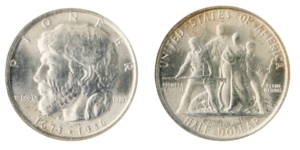
1936 Elgin Half Dollar NGC MS66
Rare half dollar coin: value for collectors and investors
Within the extensive history of half dollars, these are some stand-out pieces that have etched their mark in the world of numismatics.
1806/5 Draped Bust: a rare half dollar coin
As collectors marvel at this coin, the question naturally arises: “How rare are half dollar coins?” The 1806/5 Draped Bust Half Dollar stands as a numismatic marvel. As indicated by the absence of a mintmark on the coin, it was produced at the Philadelphia Mint with a mintage of 839,576. Its obverse and reverse design, featuring the Liberty Draped Bust, was created by Robert Scot, the Chief Engraver of the United States Mint during that period.
1806/5 Draped Bust Half NGC AU58 CAC
- Metal: Silver
- Year: 1806
- What makes this coin special: This particular specimen is set apart by its overdate feature, i.e. the digit “6” struck over a “5,” resulting from repurposing leftover dies from 1805. Beyond its minting anomaly, the coin’s well-preserved ‘Almost Uncirculated’ grade and the coveted CAC seal of approval elevate its desirability.
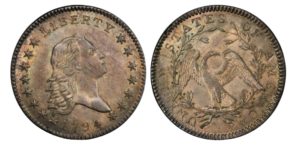
When it comes to rare half dollar coins (1776 to 1976), it is clear that this 1806 gem stands out and you can learn more about it here.
1861 Confederate States of America Restrike: one of the most unique half dollar rare coins
The answer to the question “Are half dollar coins rare?” is clear as far as the 1861 50C Confederate States of America Restrike is concerned. An extraordinary relic from a tumultuous period in American history, this coin was originally crafted during the Civil War by the Confederate States, a testament to their brief venture into minting currency. The obverse, borrowing from the United States Half Dollar, features a Liberty Cap above a shield adorned with seven stars and stripes representing the seceded Southern states.
1861 50C Confederate States of America Restrike NGC MS66
- Metal: Silver
- Year: 1861
- What makes this coin special: The coin’s captivating history contributes to its scarcity. The coin was first minted in very limited numbers, with only four of the original pieces documented, each gifted to notable figures like President Jefferson Davis. With the later restrike of the coin, which marked a numismatic milestone, it entered the collector’s realm. The NGC MS66 grade of this specimen, signifying exceptional preservation, further contributes to its desirability.
- Get our most current price here.
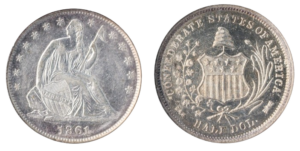
1907 Barber: one of the most sought-after rare US half dollar coins
Answering the question “Are half a dollar coins rare?” would not be complete without mentioning the 1907 Barber Half Dollar. It bears an elegant design by Chief Engraver Charles E. Barber, with Lady Liberty wearing a Phrygian cap gracing the obverse and the reverse showcasing an eagle clutching an olive branch and arrows. Struck at the Philadelphia Mint, it holds historical significance as the last year of the Barber Half Dollar series.
1907 Barber Half Dollar PCGS PR65 CAC
-
- Metal: Silver
- Year: 1907
- What makes this coin special: This coin captivates collectors with its scarcity of high-grade specimens, stemming from irregular minting quality. The irregularities in minting, ranging from striking pressure to planchet preparation, led to variations in surface conditions and details on the coins. These variations contribute to the coin’s allure, as collectors seek specimens that showcase the best possible craftsmanship despite the challenges faced during minting.
- View our most current price here.
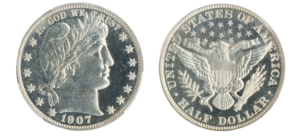
To delve deeper into the question “Why are half dollar coins rare?”, read about Barber Halves here.
1794 Flowing Hair Half Dollar: one of the most special rare half dollar coins
The 1794 Flowing Hair Half Dollar represents the first year of the denomination, which makes this early American half dollar coin rare. Inspired by the Spanish dollar in terms of size and weight, the coin was designed by Robert Scot. Its obverse captures Liberty’s bust, encircled by fifteen stars denoting the ratified states, while the reverse presents a majestic eagle surrounded by a wreath.
1794 Flowing Hair Half Dollar
-
- Metal: Silver
- Year: 1794
- What makes this coin special: With a mintage of merely 23,464 pieces, i.e. less than a tenth of the mintage of the following year, the limited circulation of this coin is part of the reason why the 1794 Flowing Hair Half Dollar is considered very rare. With only three coins in mint state and very few well-preserved examples, collectors eagerly vie for the chance to acquire them.

1971-D Kennedy: one of the most intriguing rare Kennedy half dollar coins
For many collectors seeking out rare half dollar coins, 1971 does not stand out as a particularly exciting year. However, the 1971 Kennedy half dollar stands as a captivating exception. Despite its more recent mintage, the 1971-D Kennedy Half, also referred to as 1971- D “No FG”, is a unique variety that captures the attention of savvy numismatists. Notably, this variety is missing the designer Frank Gasparro’s initials on the reverse of the coin, near the tip of the tail feathers of the eagle, due to a minting anomaly caused by a filled die. This oversight makes this coin distinct and particularly fascinating for Kennedy Half Dollar fans.
1971-D Kennedy Half Dollar
- Metal: Copper/nickel
- Year: 1971
- What makes this coin special: What makes this half dollar special extends beyond the missing initials. Its copper-nickel clad composition, distinct from earlier silver issues, adds to its allure, as it represents a transitional phase in coinage history. For knowledgeable enthusiasts, the extremely rare 1971-D mint Kennedy half dollar coin (collector’s item) is hard to resist
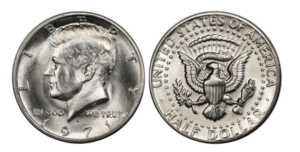
1928 Hawaiian Commemorative: one of the most unique rare half dollars coins
With respect to rare coins, half dollar commemoratives, issued to mark special events, hold historical and collectible significance. The 1928 Hawaiian Commemorative Half Dollar, celebrating the 150th anniversary of Captain James Cook’s arrival in Hawaii, stands out with its stunning design. Crafted by sculptor Chester Beach, it features the portrait of Captain James Cook on the obverse and a Hawaiian standing with a spear and cloak on the reverse.
1928 Hawaiian Commemorative Half Dollar
- Metal: Silver
- Year: 1928
- What makes this coin special: This coin provides a definitive “Yes” answer to the question “Is a half dollar coin rare if it’s commemorative?”. In contrast to some other commemorative coins of the era that were issued for speculative or commercial reasons, the 1928 Hawaiian Commemorative was created with the genuine purpose of honoring Captain Cook’s landing in the Hawaiian Islands. With a mintage of approximately 10,000, the coin was an instant hit, selling out swiftly for the price of $2 upon its release. Today, the coin’s rarity adds to its appeal.
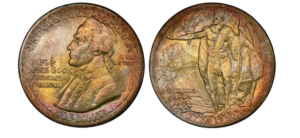
Where to buy rare US half dollar coins
In exploring this captivating realm of rare coins, one may naturally wonder, “Is the half dollar coin rare?”. As this piece has demonstrated, the answer is a resounding “yes”. Rare half dollars embody a rich tapestry of history and numismatic intrigue. From the overdated 1806/5 Draped Bust Half to the symbolic 1861 Seated Liberty Confederate States of America Restrike and the culturally significant 1928 Hawaiian Commemorative, each coin tells a unique story.
To navigate this captivating realm of rare coins, consider acquiring them from Blanchard. For insights into rare half dollar coin value and more, Blanchard team’s experts can offer trusted guidance to enhance your collecting journey.
Want to read more? Subscribe to the Blanchard Newsletter and get our tales from the vault, our favorite stories from around the world and the latest tangible assets news delivered to your inbox weekly.







